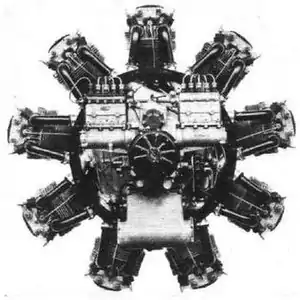Bristol Phoenix
The Phoenix was an experimental version of the Bristol Aeroplane Company's Pegasus engine, adapted to run on the Diesel cycle. Only a few were built between 1928 and 1932, although samples fitted to a Westland Wapiti held the altitude record for diesel-powered aircraft at 27,453 ft (8,368 m) from 11 May 1934 until World War II.[1] The primary advantage of the Phoenix was better fuel efficiency at cruise, by up to 35%.
| Phoenix | |
|---|---|
 | |
| Type | Diesel aircraft engine |
| Manufacturer | Bristol Aeroplane Company |
| First run | 1928 |
| Major applications | Westland Wapiti |
Variants
- Phoenix I: Diesel version of the Pegasus IF, 380 hp.
- Phoenix IIM: Medium-supercharged diesel version of Pegasus IM, 470 hp.
Applications
Specifications (Phoenix I)
Data from Lumsden[2]
General characteristics
- Type: nine-cylinder air-cooled Diesel radial engine
- Bore: 5.75 in (146 mm)
- Stroke: 7.5 in (190 mm)
- Displacement: 1,753 in³ (28.7 L)
- Length: 43.75 in (1,111 mm)
- Diameter: 55.25 in (1,403 mm)
- Dry weight: 1,067 lb (484 kg)
Components
- Valvetrain: Overhead valve, two intake and two exhaust valves per cylinder, pushrod-actuated.
- Fuel type: Diesel
- Cooling system: Air-cooled
Performance
- Power output: 380 hp (283 kW) at 2,000 rpm at sea level
- Specific power: 0.22 hp/in³ (9.9 kW/L)
- Compression ratio: 14:1
- Power-to-weight ratio: 0.36 hp/lb (0.6 kW/kg)
References
Notes
- Gunston 1989, p.32.
- Lumsden 2003, p.114.
External links
This article is issued from Wikipedia. The text is licensed under Creative Commons - Attribution - Sharealike. Additional terms may apply for the media files.